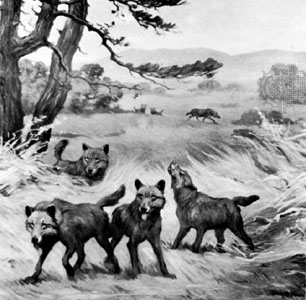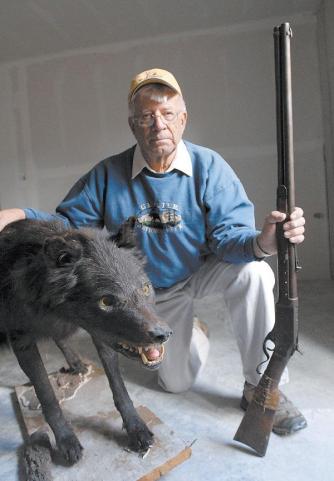
May 24, 2009
What is it? A striped hyena? An aardwolf? A dire wolf?

Dire wolf (Canis dirus) from Rancho La Brea, California; detail of a mural by Charles R. Knight, 1922.
What has a tan coat with black stripes, faintly visible?
The guesses are in, and early on May 23rd, one person (IndyDonna), at the crack of dawn and a few others later in the day, identified what was being seen in these images correctly.
Resist jumping ahead, and see how the body of this animal reveals itself.
It was an incredibly interesting exercise in seeing what could be seen in taking a piece of visual evidence out-of-context.
What did you see?
Here are the tallies.
The picks on Friday:
Dog (6)
Striped hyena (5)
Maine coon cat (3) + cat (2)
Aardwolf (3)
Lynx/Bobcat (2)
Raccoon (2)
Hamster (2)
Bigfoot (2)
Otter
Brown bear
Fox
Llama
Rodent
Weasel family
Sloth
Hamster
Red panda
Takin
Shetland pony
Badger
Guinea pig
Alpaca
Yak
African lion
Tasmanian Tiger
Ferret
Golden Lion Tamarin
Coyote
Zebra
Striped jackal
Opossum
Horse
African wild cat
Montauk Monster
Dee Snyder from Twisted Sister
William Shatner’s toupee
Donald Trump
The choices on Saturday:
Aardwolf (4)
Dog (3)
Wolf (2)
Striped hyena (2)
Dire wolf (2)
Thylacine (2)
Sloth
Weasel
Banded mongoose
Mandrill
Pig
Sabertooth
Bear
Patagonian mara
Almiqui
Golden Monkey
Echidna
Armadillo
Okapi
Wolverine
Badger
Wild dog
Coyote
Short-faced bear
Goat
Silky Chicken
Joy Behar’s back hair
So what was it? The definite striping on this animal is remarkable for what kind of animal has this kind of striping?
Here are the photographs you have been looking at during the last couple days:
You may click on the three images, and the others below, to increase their viewing size. All photographs © Lance Foster 2009.
So what do more and more photographs of this animal reveal?
Yes, this thing is the Shunka Warak’in. Pulling back, you can see what greeted Lance Foster when he went to photograph this animal, closely, for the first time last week. It looks black from a distance, but close up, parts of the body are tan, striped, and others are dark, almost black.
On Thursday, May 21, 2009, Lance Foster (above) journeyed to the museum. “I went to Ennis today and saw the ‘beast’ in person (Ringdocus a/k/a Shunka Waraki’in),” he wrote me.
“It is definitely a canid of some type, not a hyena or pig-like animal. The dentition, feet, etc. are all canid. The fur looks similar to a wolverine but that could just be the age of the mount. There are some subtle stripes, not brindled, actual stripes.
“It is in decent condition though. It was preserved in part using arsenic. The skull may be the original (the teeth look real rather than plastic).
“The proprietor said that there was a Fish and Game fellow who came by and couldn’t identify it exactly, but there is talk of doing a DNA test on some fur.”
Problem is, the museum does not own it and thus they are not allowed to do a test.
When Foster saw the animal, he had some interesting observations, in reaction to my sense from his photos that a bad taxidermy mounting had occurred:
The b/w version made it look like it was black, with a loss of hair and thus bare skin showing, but that is an illusion, as the color photo shows the overall hair color is medium brown, with darker areas and stripes.
The other thing to note is the skin behind the foreleg is quite wrinkled and distorted, which was either a flaw in the mounting process, as you say, a forced-fit over a wolf form, or a shrinkage/distortion of tissue for some other reason. Perhaps the foreleg was longer in the living animal than the mounted version.
I do think you are right that it was not the best mounting job. The description of the animal’s behavior (traveled farther in shorter time than a wolf, that he carried his head lower than the shoulders, etc.), odd screaming cries quite unlike that of a wolf, and the fact these pioneers were people who were very familiar with wolves, dogs, and coyotes did not name it as one of these, all contraindicate its identification as either a wolf or a dog.
I personally don’t think it is a hybrid either. I have seen many wolf-dogs and coy-dogs and this looks like none of them. I think the biological identity of the animal can really only be resolved through a DNA test. If it is a new canid species, so far unknown to science, wouldn’t that be something?
Lance Foster
The old postcards and b&w photos, needless to say, make the mount look mysterious. But as the above close-ups show, and this exercise in trying to identify the animal from looking at selected images of the coat, it is rather mysterious.
Lance Foster, myself, and others have looked for the mounted Shunka Warak’in for decades. Then, after 121 years of it being missing-in-action, the taxidermy mount surfaced in 2007.
But we can see now that the photograph taken two years ago seems to have hardly done it justice.

Jack Kirby with Island Park’s mystery animal. Bozeman Chronicle photo.

Shunka Warak’in, a simple black & white image for years, has been filled out with more colored photos of what it looks like. But are we any closer to knowing what it is?
+++++
The winners of the correct answer are the following individuals. Congratulations! The first person, IndyDonna, wins an autographed book of mine that I’m speeding off to her next week.
IndyDonna, btw, is a woman artist from rural Indiana, who formerly created animal woodburnt paintings. She has a keen eye for animals.
The list of people (with the timecode) guessing “Shunka Warak’in“:
IndyDonna 2009/05/23 at 8:50 AM
Alton Higgins 2009/05/23 at 10:20 AM
kgehrman 2009/05/23 at 10:25 AM
lumbarjack03 2009/05/23 at 12:34 PM
jhw1701 2009/05/23 at 3:27 PM
RobDev 2009/05/23 at 4:46 PM
Ursawolf 2009/05/23 at 5:08 PM
AlbertaSasquatch 2009/05/23 at 6:20 PM
Mark Wallbank 2009/05/23 at 8:03 PM
Congratulations! All nine people above, on Saturday, used what was visible to correctly deduce that this was something we don’t really know what it is, but which does go by the name “Shunka Warak’in,” for now.
A cryptid was located and found, but what it is remains elusive.
Let me leave you with RobDev’s and Ursawolf’s comments:
“I had an odd thought, so I looked up the article on finding the Shunka Warak’in. The description in that article said ‘Its coat is dark-brown, almost black, with lighter tan areas and a faint impression of stripes on its side.’ Could the photos be of the lighter tan areas?” ~ RobDev.
“Oh, come on! It HAS to be the mounted ‘Shunka Warak’in’ – I compared the photos with those posted on this site before. I’ve been fascinated with the stories of this beastie….it was the stripes that made me go back and compare it with other photos. The fur looked wolf-like to me, but everyone had already guessed the striped, dog-like critters (anyway, the hyena and thylacine are the only two that come to my mind). So that leaves us with the enigmatic ‘Ringdocus.’ So…has DNA testing been possible on the specimen?” ~ Ursawolf.
One answer has now been given, but, of course, more questions remain.
All photographs © Lance Foster 2009. Used with exclusive permission at Cryptomundo.
Thank you for remembering the International Cryptozoology Museum…
🙂 Thank You.
About Loren Coleman
Loren Coleman is one of the world’s leading cryptozoologists, some say “the” leading living cryptozoologist. Certainly, he is acknowledged as the current living American researcher and writer who has most popularized cryptozoology in the late 20th and early 21st centuries.
Starting his fieldwork and investigations in 1960, after traveling and trekking extensively in pursuit of cryptozoological mysteries, Coleman began writing to share his experiences in 1969. An honorary member of Ivan T. Sanderson’s Society for the Investigation of the Unexplained in the 1970s, Coleman has been bestowed with similar honorary memberships of the North Idaho College Cryptozoology Club in 1983, and in subsequent years, that of the British Columbia Scientific Cryptozoology Club, CryptoSafari International, and other international organizations. He was also a Life Member and Benefactor of the International Society of Cryptozoology (now-defunct).
Loren Coleman’s daily blog, as a member of the Cryptomundo Team, served as an ongoing avenue of communication for the ever-growing body of cryptozoo news from 2005 through 2013. He returned as an infrequent contributor beginning Halloween week of 2015.
Coleman is the founder in 2003, and current director of the International Cryptozoology Museum in Portland, Maine.
Filed under Artifacts, Cryptomundo Exclusive, Cryptotourism, CryptoZoo News, Cryptozoologists, Cryptozoology, Megafauna, Photos